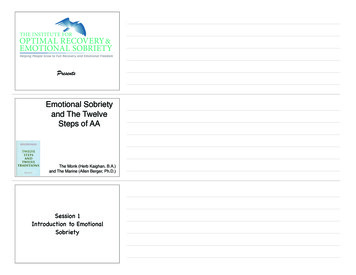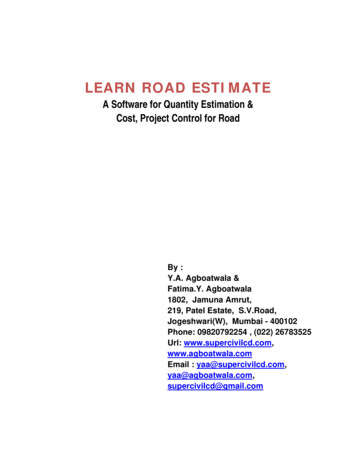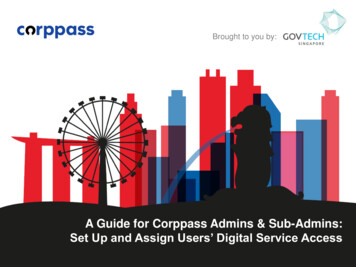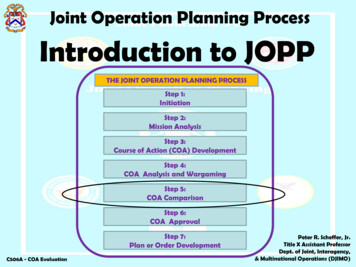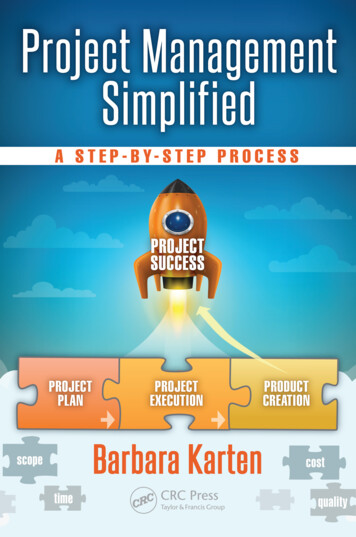
Transcription
Project ManagementSimplifiedA S T E P - B Y- S T E P P R O C E S S
Industrial Innovation SeriesSeries EditorAdedeji B. BadiruAir Force Institute of Technology (AFIT) – Dayton, OhioPUBLISHED TITLESCarbon Footprint Analysis: Concepts, Methods, Implementation, and Case Studies,Matthew John Franchetti & Defne ApulCellular Manufacturing: Mitigating Risk and Uncertainty, John X. WangCommunication for Continuous Improvement Projects, Tina AgustiadyComputational Economic Analysis for Engineering and Industry, Adedeji B. Badiru &Olufemi A. OmitaomuConveyors: Applications, Selection, and Integration, Patrick M. McGuireCulture and Trust in Technology-Driven Organizations, Frances AlstonGlobal Engineering: Design, Decision Making, and Communication, Carlos Acosta, V. Jorge Leon,Charles Conrad, & Cesar O. MalaveGlobal Manufacturing Technology Transfer: Africa–USA Strategies, Adaptations, and Management,Adedeji B. BadiruGuide to Environment Safety and Health Management: Developing, Implementing, andMaintaining a Continuous Improvement Program, Frances Alston & Emily J. MillikinHandbook of Emergency Response: A Human Factors and Systems Engineering Approach,Adedeji B. Badiru & LeeAnn RaczHandbook of Industrial Engineering Equations, Formulas, and Calculations, Adedeji B. Badiru &Olufemi A. OmitaomuHandbook of Industrial and Systems Engineering, Second Edition, Adedeji B. BadiruHandbook of Military Industrial Engineering, Adedeji B. Badiru & Marlin U. ThomasIndustrial Control Systems: Mathematical and Statistical Models and Techniques,Adedeji B. Badiru, Oye Ibidapo-Obe, & Babatunde J. AyeniIndustrial Project Management: Concepts, Tools, and Techniques, Adedeji B. Badiru,Abidemi Badiru, & Adetokunboh BadiruInventory Management: Non-Classical Views, Mohamad Y. JaberKansei Engineering—2-volume set Innovations of Kansei Engineering, Mitsuo Nagamachi & Anitawati Mohd Lokman Kansei/Affective Engineering, Mitsuo NagamachiKansei Innovation: Practical Design Applications for Product and Service Development,Mitsuo Nagamachi & Anitawati Mohd LokmanKnowledge Discovery from Sensor Data, Auroop R. Ganguly, João Gama, Olufemi A. Omitaomu,Mohamed Medhat Gaber, & Ranga Raju VatsavaiLearning Curves: Theory, Models, and Applications, Mohamad Y. JaberManaging Projects as Investments: Earned Value to Business Value, Stephen A. DevauxModern Construction: Lean Project Delivery and Integrated Practices, Lincoln Harding Forbes &Syed M. AhmedMoving from Project Management to Project Leadership: A Practical Guide to Leading Groups,R. Camper BullProject Management: Systems, Principles, and Applications, Adedeji B. Badiru
PUBLISHED TITLESProject Management for the Oil and Gas Industry: A World System Approach, Adedeji B. Badiru &Samuel O. OsisanyaProject Management Simplified: A Step-by-Step Process, Barbara KartenQuality Management in Construction Projects, Abdul Razzak RumaneQuality Tools for Managing Construction Projects, Abdul Razzak RumaneSocial Responsibility: Failure Mode Effects and Analysis, Holly Alison Duckworth &Rosemond Ann MooreStatistical Techniques for Project Control, Adedeji B. Badiru & Tina AgustiadySTEP Project Management: Guide for Science, Technology, and Engineering Projects,Adedeji B. BadiruSustainability: Utilizing Lean Six Sigma Techniques, Tina Agustiady & Adedeji B. BadiruSystems Thinking: Coping with 21st Century Problems, John Turner Boardman & Brian J. SauserTechonomics: The Theory of Industrial Evolution, H. Lee MartinTotal Productive Maintenance: Strategies and Implementation Guide, Tina Agustiady& Elizabeth A. CudneyTotal Project Control: A Practitioner’s Guide to Managing Projects as Investments,Second Edition, Stephen A. DevauxTriple C Model of Project Management: Communication, Cooperation, Coordination,Adedeji B. BadiruFORTHCOMING TITLES3D Printing Handbook: Product Development for the Defense Industry, Adedeji B. Badiru& Vhance V. ValenciaCompany Success in Manufacturing Organizations: A Holistic Systems Approach,Ana M. Ferreras & Lesia L. Crumpton-YoungDesign for Profitability: Guidelines to Cost Effectively Management the Development Processof Complex Products, Salah Ahmed Mohamed ElmoselhyEssentials of Engineering Leadership and Innovation, Pamela McCauley-Bush &Lesia L. Crumpton-YoungHandbook of Construction Management: Scope, Schedule, and Cost Control,Abdul Razzak RumaneHandbook of Measurements: Benchmarks for Systems Accuracy and Precision, Adedeji B. Badiru& LeeAnn RaczIntroduction to Industrial Engineering, Second Edition, Avraham Shtub & Yuval CohenManufacturing and Enterprise: An Integrated Systems Approach, Adedeji B. Badiru,Oye Ibidapo-Obe & Babatunde J. AyeniProject Management for Research: Tools and Techniques for Science and Technology,Adedeji B. Badiru, Vhance V. Valencia & Christina RusnockA Six Sigma Approach to Sustainability: Continual Improvement for Social Responsibility,Holly Allison Duckworth & Andrea Hoffmeier ZimmermanWork Design: A Systematic Approach, Adedeji B. Badiru
This page intentionally left blank
Project ManagementSimplifiedA S T E P - B Y- S T E P P R O C E S SBoca Raton London New YorkCRC Press is an imprint of theTaylor & Francis Group, an informa business
CRC PressTaylor & Francis Group6000 Broken Sound Parkway NW, Suite 300Boca Raton, FL 33487-2742 2016 by Taylor & Francis Group, LLCCRC Press is an imprint of Taylor & Francis Group, an Informa businessNo claim to original U.S. Government worksVersion Date: 20151228International Standard Book Number-13: 978-1-4987-2935-2 (eBook - PDF)This book contains information obtained from authentic and highly regarded sources. Reasonable effortshave been made to publish reliable data and information, but the author and publisher cannot assumeresponsibility for the validity of all materials or the consequences of their use. The authors and publishershave attempted to trace the copyright holders of all material reproduced in this publication and apologize tocopyright holders if permission to publish in this form has not been obtained. If any copyright material hasnot been acknowledged please write and let us know so we may rectify in any future reprint.Except as permitted under U.S. Copyright Law, no part of this book may be reprinted, reproduced, transmitted, or utilized in any form by any electronic, mechanical, or other means, now known or hereafter invented,including photocopying, microfilming, and recording, or in any information storage or retrieval system,without written permission from the publishers.For permission to photocopy or use material electronically from this work, please access www.copyright.com (http://www.copyright.com/) or contact the Copyright Clearance Center, Inc. (CCC), 222 RosewoodDrive, Danvers, MA 01923, 978-750-8400. CCC is a not-for-profit organization that provides licenses andregistration for a variety of users. For organizations that have been granted a photocopy license by the CCC,a separate system of payment has been arranged.Trademark Notice: Product or corporate names may be trademarks or registered trademarks, and are usedonly for identification and explanation without intent to infringe.Visit the Taylor & Francis Web site athttp://www.taylorandfrancis.comand the CRC Press Web site athttp://www.crcpress.com
ContentsListofFi g u r e sListofTa b l e sxiiixvxviiP r e fa c exixAuthorChapter 1P r o j e c t s : Th e B i g P i c t u r r 2The Project CoreScope ComponentSchedule ComponentBudget ComponentQuality ComponentRisk ComponentToolkitProject ContextStakeholders, Communication, and TeamingConnect the Dots (Integration)After the Plan: The Team Must ExecuteWe Learn Best by DoingCheckpointProject Charter2.12.2Deck ProjectProject Charter Contents2.2.1 Checkpoint1335667899910101113141519vii
viiiChapter 3C o n t en t sProject Scope3.13.23.33.43.5Chapter 4Project Schedule4.14.24.34.44.54.64.7Chapter 56.4Quality Project versus Quality ProductSubjective versus MeasureableQuality Plan6.3.1 CheckpointNext StepsP roj ec t Ri s ks7.17.27.37.47.57.67.77.87.97.107.11Chapter 8Accounting for Apparently Free Labor ResourcesProject FundingBudget for the Deck Project5.3.1 CheckpointP r o j e c t Q ua l i t y6.16.26.3Chapter 7CheckpointSchedule Network Diagram4.2.1 CheckpointProject DurationHow Much versus How LongWhat about Resources?Building the Project ScheduleDetermine Schedule4.7.1 CheckpointProject Budget5.15.25.3Chapter 6Scope: Telescope to MicroscopeProject Scope Statement3.2.1 CheckpointWork Breakdown StructureDecomposition of the Deck Project intoWBS Categories3.4.1 CheckpointNext StepsNaming the RisksRisk CategoriesList of Risks for the Deck ProjectCheckpointProbability and ImpactRisk ScoreCheckpointRisk Response PlansRisk Response StrategiesCheckpointNext StepsP r o j e c t To o l k i 3545555606161626265656768696970717175757780818384
C o n t en t s8.28.38.48.5Chapter 9Standards84Tactics858.3.1 Lists868.3.2 Graphic Displays of Information868.3.3 Meetings888.3.4 Managing by Walking Around90908.3.5 Sticky Notes8.3.6 Brainstorming91Cross-Project Processes928.4.1 Change Management92948.4.1.1 Checkpoint8.4.2 Decision Making948.4.2.1 Checkpoint978.4.3 Conflict Management978.4.3.1 Checkpoint988.4.4 Project Life Cycle: Planning versus Executing 988.4.4.1 Checkpoint100Project Toolkit Summary100Project Conte xtC h a p t e r 10 P r o j e c t S ta k e h o l d e r s10.110.210.310.4What’s in It for Me?Identify Project Stakeholders10.2.1 CheckpointOrganizing the Stakeholders10.3.1 CheckpointStakeholder Engagement10.4.1 CheckpointC h a p t e r 11 P r o j e c t C o m m u n i c at i o n11.111.211.311.411.5Communication PlanWhat to Communicate11.2.1 CheckpointPush or Pull11.3.1 CheckpointMarketing and Branding11.4.1 CheckpointNext StepsC h a p t e r 12 P r o j e c t Te a m i n g12.112.212.312.4ixTeamingStages of Team DevelopmentTeam Building12.3.1 CheckpointCoordination of Work: Sorting Out Team Roles andResponsibilities12.4.1 Responsibility Assignment 119119120120121121123124125125125
xC o n t en t s12.512.4.4.1 Checkpoint12.4.2 Organization Charts12.4.2.1 CheckpointNext StepsC h a p t e r 13 C o n n e c t t h e D o t s : I n t e g r at i n gProject 15.8theP l a n, We E x e c u t eThe Product of the ProjectExecution of the Deck ProjectNext StepsC h a p t e r 15 S t e p s15.1theHow Much Planning Does a Project Need?Project Plan Document ApprovalsProject Plan13.3.1 CheckpointNext StepsC h a p t e r 14 A f t e r14.114.214.3127129130130toE x e c u t e Yo u r P r o j e c tStep 1: Create a Project Charter15.1.1 Checkpoint for Project Status15.1.2 Risks of No Written Project CharterStep 2: Create the Project Scope Statement15.2.1 Checkpoint for Project Status15.2.2 Risks of No Written Scope StatementStep 3: Create Stakeholder Matrix15.3.1 Checkpoint for Project Status15.3.2 Risks of No Written Stakeholder MatrixStep 4: Create Stakeholder Engagement Matrix15.4.1 Checkpoint for Project Status15.4.2 Risks of No Written StakeholderEngagement MatrixStep 5: Create the Communication Plan15.5.1 Checkpoint for Project Status15.5.2 Risks of No Written Communication PlanStep 6: Teaming, Create RAM for Documents,Create Organization Chart15.6.1 Checkpoint for Project Status15.6.2 Risks of No Written List of TeamingActivities, RAM for Project Documentsand Project Organization ChartStep 7: Create the Work BreakdownStructure (WBS), RAM for WBS Work Packages15.7.1 Checkpoint for Project Status15.7.2 Risks of Not Creating a WBSStep 8: Create the Project 1151152
xiC o n t en t 15.1315.14WBS Extended to Include TasksSchedule Network DiagramProject ScheduleCheckpoint for Project StatusRisk of Not Creating an Extended WBS,Schedule Network Diagram, and ProjectScheduleStep 9: Create the Project Budget15.9.1 Checkpoint for Project Status15.9.2 Risk of Not Completing a Project BudgetStep 10: Create the Quality Plan15.10.1 Checkpoint for Project Status15.10.2 Risk of Not Completing a Quality PlanStep 11: Identify Risks15.11.1 Checkpoint for Project Status15.11.2 Risk of Not Doing a Risk PlanStep 12: Publish the Project Plan15.12.1 Checkpoint for Project Status15.12.2 Risk of Not Integrating and Publishing theProject PlanStep 13: Execution15.13.1 Checkpoint for Project Status15.13.2 Risk of Not Executing According to theProject PlanStep 14: CongratulationsG lo s sa 160160160160161163A pp e n d i x A: C o m m u n i t y G a r d e n s P r o j e c t171A pp e n d i x B: P r o j e c t C h a r t e r175A pp e n d i x C: P r o j e c t S c o p e S tat e m e n t179A pp e n d i x D: W o r k B r e a k d o w n S t r u c t u r e183A pp e n d i x E: W o r k B r e a k d o w n S t r u c t u r ewithTa s k s187A pp e n d i x F: S c h e d u l e N e t w o r k D i a g r a m191A pp e n d i x G: P r o j e c t S c h e d u l e195A pp e n d i x H: P r o j e c t B u d g e t203A pp e n d i x I:209P r o j e c t Q ua l i t y P l a nA pp e n d i x J: R i s k sand213R i s k C at e g o r i e sA pp e n d i x K: R i s k S c o r e s , P r o b a b i l i t yS calesandI m pa c t217A pp e n d i x L: R i s k R e s p o n s e P l a n s221A pp e n d i x M: S ta k e h o l d e r M at r i x225A pp e n d i x N: S ta k e h o l d e r E n g a g e m e n t M at r i x229
x iiC o n t en t sA pp e n d i x O: P r o j e c t C o m m u n i c at i o n P l a nA pp e n d i x P: R e s p o n s i b i l i t y A s s i g n m e n t M at r i c e sA pp e n d i x Q: O r g a n i z at i o n C h a r tA pp e n d i x R: P r o j e c t E x e c u t i o nIndex233237241243253
List of FiguresFigure 1.1The project core puzzle4Figure 1.2Project core puzzle mismatch4Figure 1.3Project core puzzle surrounded by risk7Figure 2.1Project charter for deck project18Figure 3.1Project scope statement for deck project26Figure 3.2WBS for deck project—Graphical format28Figure 3.3WBS for deck project—Sticky note format30Figure 4.1Extended WBS for the deck project—Sticky note format35Figure 4.2Extended WBS for the deck project—Graphical format36Figure 4.3 Schedule network diagram for the deck project—Sticky noteformat39Figure 4.4Schedule network diagram for the deck project—Graphical format40Figure 4.5Project duration43Figure 4.6Schedule for deck project47Figure 5.1Budget for deck project56Figure 7.1Risk response plan deck project—Negative risk79Figure 7.2Risk response plan deck project—Positive risk80x iii
xivLis t o f Fi gure sFigure 8.1Community Gardens cookbook monthly data88Figure 8.2 Community Gardens cookbook cumulative data88Figure 9.1Project environment102Figure 10.1 Power interest grid107Figure 11.1 Stakeholder relationships115Figure 12.1 Organization chart for deck project130Figure 13.1 Connect the dots132Figure 14.1 Change request and analysis for deck project139Figure 14.2 Lessons learned for deck project140Figure B.1Project charter for Community Gardens project176Figure C.1Project scope statement for Community Gardens project180Figure D.1 W BS for Community Gardens project—Sticky note format184Figure D.2 W BS for Community Gardens project—Graphical format184Figure E.1E xtended WBS for Community Gardens project—Sticky noteformat188Figure E.2 Extended WBS for Community Gardens project—Graphicalformat189Figure F.1S chedule network diagram for Community Gardens project—Sticky note format192Figure F.2 Schedule network diagram for Community Gardens project—Graphical format193Figure G.1Schedule for the Community Gardens project197Figure H.1Budget for Community Gardens project205Figure L.1R isk response plan for CG project—Negative risk223Figure L.2Risk response plan for CG project—Positive risk224Figure Q.1 Organization chart for Community Gardens project241Figure R.1Season kick off meeting agenda245Figure R.2Change request and analysis—Loaner car246Figure R.3 Lessons learned—Community Gardens project248
List of TablesTable 4.1Extended WBS for deck Project—Outline format37Table 6.1Quality plan for deck project66Table 7.1 R isk categories69Table 7.2 R isks for deck project70Table 7.3Probability and impact scales72Table 7.4P robability, impact, and risk score73Table 7.5Risk scores for deck project74Table 8.1 Project toolkit85Table 8.2Community Gardens cookbook sales data87Table 10.1 Stakeholder matrix for deck project107Table 10.2 Stakeholder engagement matrix for deck project111Table 11.1 Communication plan for deck project118Table 12.1 RAM for team members and project documents126Table 12.2 R AM for relationship of team members and project documents127Table 12.3 RAM for deck project documents128Table 12.4 RAM for deck project deliverables129Table 13.1 Project plan approvals134xv
xviLis t o f Ta b l e sTable 13.2 Project plan contents136Table 14.1 Quality plan for deck project—Post-project completion141Table D.1WBS for Community Gardens project—Outline format185Table E.1 Extended WBS for Community Gardens project—Outline format190Table I.1Quality plan for Community Gardens project210Table J.1Risk categories214Table K.1Probability and impact scales218Table K.2Risk scores for Community Gardens project219 takeholder matrix for Community Gardens projectTable M.1 S227Table N.1230S takeholder engagement matrix for Community Gardens projectTable O.1 C ommunication plan for Community Gardens project234Table P.1RAM for project documents for Community Gardens project238Table P.2 R AM for WBS deliverables for Community Gardens project239Table R.1 Quality plan for Community Gardens project—Post-projectcompletion249
PrefaceProjects are like a box of chocolates; you never know what you aregoing to get. Sometimes projects are simple, almost common sense.Other times, the complexity is overwhelming. But even apparentlysimple projects often run late, over budget, and fail to deliver onpromised capabilities.The Chaos Reports by the Standish Group suggest that 50% ofinformation technology projects in the business world are challenged;they do not satisfy the scope, schedule, and budgetary requirements.My anecdotal observations suggest that personal, nonbusiness projects have a similar failure rate.Maybe common sense is not simple. Perhaps there is an astoundinglack of common sense among people working on projects. Voltairesuggests that “Common sense is not so common.” Predictable projectperformance requires more than common sense.Project management is a set of processes and a framework thatenhances the opportunity for project success. It is a form of insurancefor projects or situations where project success is important.There are a number of structured approaches that guide thesuccessful completion of projects in business environments. The Project Management Institute (PMI) documents a framework in itsProject Management Body of Knowledge (PMBoK) standard. ProjectManagement Institute Education Foundation (PMIEF) applies thex vii
x viiiP refac ePMBoK principles to nonprofit, educational, and nongovernmentorganizations. Prince2 is another project management methodologythat originated from the UK government.These processes apply to our personal projects. This book translatesthese processes and techniques such that nonproject managers caneasily use these proven approaches in a nonbusiness context for theirown projects. It removes technical jargon, the need for computer software and hardware, and complicated organizational environments,describing the essential project management processes in a simple,straightforward manner.Many people are not project managers at work, but might benefitfrom the application of project management principles on their job.Many of us have personal projects that are challenged in that they areoften completed late and over budget, and “not quite right” in theirfeatures, functions, and capabilities. This book is for these people.
AuthorBarbara Karten, PMP, has over 20 years of management, project/product/program management, and consulting/training experience.Since 2003, she has been an independent consultant and trainer delivering project management and business systems analysis training,PMP (project management professional) exam preparation training,general project management courses for continuing education credits, PMI (Project Management Institute) Chapter-sponsored studygroups, and project management courses both online and on groundfor graduate and undergraduate programs at local universities.Barbara began her career with a focus on the application of systemsmethodology to human service systems development and operations.Over time, her interest in organizational effectiveness developed intoa focus on requirements and business processes, and into positionsas a business systems analyst for technology companies. Building onthis experience, Barbara assumed responsibility for the managementof projects and programs, for software and hardware in high technology companies.In addition to her work with nonprofit human service agenciesand for profit technology companies, Barbara taught project management at local universities, including University of Phoenix, WorcesterPolytechnic Institute, and Northeastern University. She developedand updated PMP curricula and course materials for academia andxix
xxAu t h o rlocal project management training providers. She has presented atindustry conferences as a panelist and a speaker.Barbara is a past president of the Central Mass PMI Chapter andis the Central Mass PMI Chapter liaison to the PMIEF (ProjectManagement Institute Education Foundation), which addresses theproject management needs of not-for-profit organizations, educational organizations, and NGOs.She has the Project Management Institute PMP certification, SixSigma Green Belt certification, and Microsoft Technology Specialistcertification for MS Project 2010 (MCTS). From Boston University,she has certificates in Project Management and Business SystemsAnalysis, a master’s degree in Computer Information Systems (MCIS),a master’s degree in Urban Affairs (MUA), and a BA in psychology.Barbara advocates project management skills as core competencies for life, education, career, and personal projects. She believes thatpeople with project management capabilities are competitively positioned to succeed.
1P rojectsThe Big PictureAre projects a problem? Do your projects cost too much, take toolong, or are just not quite right? If so, this book is for you; it is a nononsense approach to projects—no jargon, just the facts.Projects are all about change. They are temporary and have adefined beginning and end. They produce something unique; it maybe a product, a service, or a result. Projects may be small or large,short term or long term, low risk or high risk. Planting a garden, planning a wedding, or changing jobs are all examples of projects.Well-defined processes for managing projects have proven effectiveat delivering project success. This book applies these project processes tomanaging change in our lives. It views project management as a life skill.Project management is for everyone; unlike other books about project management, this book focuses on the following: Everyday, low technology projects Simple, easy-to-use techniques for managing scope, schedule,budget, and quality Easily understood, jargon-free explanations of effective project management techniques Noncorporate projects Nonbusiness-focused project managementThe book describes an approach modeled on a project process usedsuccessfully in businesses, not-for-profit organizations, schools, andother organizations. The skills and techniques are not unique tobusinesses and organizations; they are life skills available to everyone. This book presents a simplified version of the complete projectmanagement methodologies used in businesses. For simpler, less riskyprojects, the project and project team may not need all the components used in the business environment.1
2P r o jec t M a n ag em en t SimplifiedThis is a journey, an adventure. Remember as children, we playeda game called “Connect the Dots”? Once we connected all the dots,we had a picture of an animal, a basket, or a vehicle. As we progressthrough this book, we connect the dots necessary to complete ourpersonal projects. This is our journey from the dreams you imagine totheir realization.The book includes a sample project in the text and a case studyin the appendices that further illustrate the concepts explained inthe text. This book also challenges the reader to select a project and,working along with the book, be the project manager and develop aproject plan for this project. The project manager, working with thecustomers and funders of the project, defines the project and, based onthis project definition, identifies how long it will take and how muchit will cost. This begins the picture of connecting the dots.The project manager writes this information down and builds onthe initial information as he progresses through this journey. If hedoesn’t write down the information as he creates and collects it, hewill likely have conversations as follows: Do you remember what we agreed to? I don’t remember it that way. I think that we said . We can’t take that long; we need to be finished by the end ofthe school year. I’m sure we agreed on gluten-free alternatives for our guests. We said we’d not spend more than xxx.To avoid this confusion, the project manager writes down the decisions and agreements as they happen. He documents the informationin the project plan.Once the project manager has a picture of the goal, he identifiesprocesses, methods, tools, and templates that enable the project toreach the goal.The project manager is really doing two separate things. He identifies the project goals and a plan to reach that goal. Maybe the goal isa thing (like a deck or pool for the yard) or a successful event (like awedding, trip, or community event), or it might be simply a change(like moving from one place to another or changing jobs). The project is what the stakeholders do to cause the goal to happen. Broadly
P r o jec t s3defined, a stakeholder is anyone positively or negatively affectedby the project. We often call the goal “the product”—so we have aproduct of our project. Building a deck, having a successful event,or effectively changing the place of residence happens as a result of aprocess—and collectively these processes are our project.Prior to project initiation, the person paying for the project (calledthe project sponsor) identifies the high level project and product detailsin the form of a project charter. This serves as a contract between thesponsor and the project manager; it is the basis for the details of theproject.This book includes information about the project core, project risks,a project toolkit, project context, and project execution.1.1 The Project CoreOnce the project manager has an agreement and sign off on highlevel project and product details in the project charter, he collectsmore information and elaborates on the initial project and productdetails. He talks to the project stakeholders and secures their perspective on the project and the product of the project. He needs tounderstand their requirements, the “features and functions” theyexpect, and any considerations with respect to schedule, budget,and quality. He writes down these details and secures appropriatestakeholder sign off on this information. This is the project core. Theproject core contains the interrelated components of scope, schedule,budget, and quality. If a project has more scope (features/functions)or needs greater quality, then it will likely take longer and/or costmore. In this way, the core components are like a puzzle as shown inFigure 1.1.If scope gets bigger or smaller or changes shape, then the puzzlepieces no longer fit. The project manager makes changes to otherjigsaw puzzle pieces to get everything in synch (Figure 1.2).1.2 Scope ComponentFor the scope component, the project manager elaborates the detailsof the project; he defines “the what” of the project. For example, if the
4P r o jec t M a n ag em en t SimplifiedTimeScopeBudgetFigure 1.1QualityThe project core puzzle.ScopeTimeBudgetFigure 1.2Project core puzzle mismatch.Quality
P r o jec t s5project is to develop a game plan for a baseball team, he clarifies whatis included in the effort such as The strategies for the players on the fieldThe signals between various playersBase stealing strategiesThe guidelines for players in the dugoutThe pre-game warm upThe pre-season training campThe logistics for getting the team to the pre-season trainingcamp and the details of the program Management of the press Ball park logistics including ticket sales, parking, food, anddrink concessions And anything else included in the effortThe project scope determines the other core components. The level ofeffort, schedule, budget, and resources all vary based on answers tothe questions above. Agreement on these details among stakeholders allows the project team to develop accurate details for effort, cost,schedule, budget, and resources.1.3 Schedule ComponentFrom a schedule perspective, is it enough to know that it takes 8 weeksto complete the project? In week 7, the project manager may realizethat he will not complete the work per the original commitment, andnow it’s too late to fix it. If he schedules the work so that he knowswhat needs to be complete by the end of week 1, week 2, and so on,he identifies schedule slips early and may be able to take actions (addresources, do work concurrently) so that he still completes the workaccording to the original schedule completion date. The project manager’s goal is predictability and completing work according to plan. Heaugments the end date of the p
vii Contents List of figures xiii List of tabLes xv Preface xvii author xix chaPter 1 Projects: the big Picture 1 1.1 The Project Core 3 1.2 Scope Component 3 1.3 Schedule Component 5 1.4 Budget Component 6 1.5 Quality Component 6 1.6 Risk Component 7
